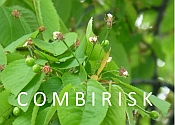Indicator(s) for |
Applied for |
Hot spots Austria and relevance |
Drought |
All selected crops |
All regions with less than 800mm annual precipitation and high temperatures and wind (especially eastern parts of Austria); relevant for crop stress and pest development |
Heat |
Annual crops |
Warmest regions of Austria, mainly lowland regions in the east and south; heat stress and fertility impact on several crops; related increased ozone levels leading to yield losses |
Soil conditions for crop (root) growth |
Annual crops |
All regions with loamy-clay soils (critical temperatures and wetness) and sandy soils (drought) |
Heavy precipitation |
Field crops |
Especially humid regions (alpine and pre-alpine regions); relevant for lodging and diseases as well as soil surface hardening |
Snow cover conditions |
Annual winter crops |
In all regions with extreme snow cover variation (too much, too long or too less ) |
Overwintering conditions |
Selected crops |
Frequency and duration of mild/cold fluctuations during winter; weakening frost hardiness, chilling conditions |
Humidity and leaf wetness |
Selected crops |
Humid crop growing regions; important conditions for many diseases |
Harvest conditions |
Selected crops |
Crop specific, include all weather parameters |
Soil workability |
Arable crops |
For soil cultivation and crop management; danger of soil compaction |
Suitable conditions for crop management measures |
Selected crops |
i.e. number of frequency of dry / calm days within certain periods, crop specific |
Drying conditions |
Annual crops |
Field drying conditions, relevant for yield quality and diseases (i.e. fusarium) |
Frequency of rains |
Selected crops |
Relevant for diseases and pests; biomass accumulation (low radiation and cloudiness) |
Frost damage |
Many crops, but especially orchards |
Especially spring crops and orchards; huge damage potential for sensitive crops; strong impact of orography |
Soil erosion |
All cropping systems with periods of bare soils |
Direct damage and long term effects on soil fertility (and nutrient and water storage capacity); strong effect of soil cover and orography |
N-leaching |
Annual crops |
Cereals and high yielding crops such as maize; strong impact of soil conditions and crop management, high spatial variability |
Disease risks
(indicative as pre-selected based on partners experience and available data sets) |
Potatoes, apples, grapes |
Preselected disease risks included in the study and involved partners:
-Potato blight (Phytophtora investans + Alternaria solani) - (CzechGlobe, MELES)
-Apple scab (Venturia inaequalis) - (UNSAF, AGES)
-Fire blight (Erwinia amylovora) - (UNSAF, AGES) -Grapevine downy mildew (Plasmopara viticola) - (UNSAF) |
Pest risks
(indicative as pre-selected based on partners experience and available data sets) |
Field crops
Orchards |
Preselected disease risks included in the study and involved partners:
-European Corn Borer - (CzechGlobe)
-Western Corn Root worm - (CzechGlobe, AGES)
-Wireworms (Coleoptera, Fam. Elateridae) - (MELES)
-Codling moth (Cydia pomonella) - (AGES)
-Plum Fruit Moth (Grapholita funebrana) - (AGES)
-Colorado Potato Beetle (Leptinotarsa decemlineata) – AGES, MELES) |

